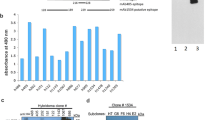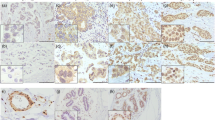Abstract
Breast cancer is the most common malignancy among North American women. The identification of factors that predict outcome is key to individualized disease management and to our understanding of breast oncogenesis. We have analyzed mRNA expression of protein elongation factor eEF1A2 in two independent breast tumor populations of size n = 345 and n = 88, respectively. We find that eEF1A2 mRNA is expressed at a low level in normal breast epithelium but is detectably expressed in approximately 50–60% of primary human breast tumors. We have derived an eEF1A2-specific antibody and measured eEF1A2 protein expression in a sample of 438 primary breast tumors annotated with 20-year survival data. We find that high levels of eEF1A2 protein are detected in 60% of primary breast tumors independent of HER-2 protein expression, tumor size, lymph node status, and estrogen receptor (ER) expression. Importantly, we find that high eEF1A2 is a significant predictor of outcome. Women whose tumor has high eEF1A2 protein expression have an increased probability of 20-year survival compared to those women whose tumor does not express substantial eEF1A2. In addition, eEF1A2 protein expression predicts increased survival probability in those breast cancer patients whose tumor is HER-2 negative or who have lymph node involvement.
Similar content being viewed by others
References
Cianfrocca M, Goldstein LJ (2004) Prognostic and predictive factors in early-stage breast cancer. Oncologist 9(6):606–616
Weigelt B, Peterse JL, van’t Veer LJ (2005) Breast cancer metastasis: markers and models. Nat Rev Cancer 5(8):591–602
Huang E, Cheng SH, Dressman H, Pittman J, Tsou MH, Horng CF, Bild A, Iversen ES, Liao M, Chen CM et al (2003) Gene expression predictors of breast cancer outcomes. Lancet 361(9369):1590–1596
West M, Blanchette C, Dressman H, Huang E, Ishida S, Spang R, Zuzan H, Olson JA Jr, Marks JR, Nevins JR (2001) Predicting the clinical status of human breast cancer by using gene expression profiles. Proc Natl Acad Sci USA 98(20):11462–11467
van’t Veer LJ, Dai H, van de Vijver MJ, He YD, Hart AA, Mao M, Peterse HL, van der Kooy K, Marton MJ, Witteveen AT et al (2002) Gene expression profiling predicts clinical outcome of breast cancer. Nature 415(6871):530–536
Wu TD (2001) Analysing gene expression data from DNA microarrays to identify candidate genes. J Pathol 195(1):53–65
Debouck C, Goodfellow PN (1999) DNA microarrays in drug discovery and development. Nat Genet 21(Suppl 1):48–50
Marton MJ, DeRisi JL, Bennett HA, Iyer VR, Meyer MR, Roberts CJ, Stoughton R, Burchard J, Slade D, Dai H et al (1998) Drug target validation and identification of secondary drug target effects using DNA microarrays. Nat Med 4(11):1293–1301
Anand N, Murthy S, Amann G, Wernick M, Porter LA, Cukier IH, Collins C, Gray JW, Diebold J, Demetrick DJ et al (2002) Protein elongation factor EEF1A2 is a putative oncogene in ovarian cancer. Nat Genet 31(3):301–305
Hershey JW (1991) Translational control in mammalian cells. Annu Rev Biochem 60:717–755
Condeelis J (1995) Elongation factor 1 alpha, translation and the cytoskeleton. Trends Biochem Sci 20(5):169–170
Shiina N, Gotoh Y, Kubomura N, Iwamatsu A, Nishida E (1994) Microtubule severing by elongation factor 1 alpha. Science 266(5183):282–285
Knudsen SM, Frydenberg J, Clark BF, Leffers H (1993) Tissue-dependent variation in the expression of elongation factor-1 alpha isoforms: isolation and characterisation of a cDNA encoding a novel variant of human elongation-factor 1 alpha. Eur J Biochem 215(3):549–554
Shultz LD, Sweet HO, Davisson MT, Coman DR (1982) ‘Wasted’, a new mutant of the mouse with abnormalities characteristic to ataxia telangiectasia. Nature 297(5865):402–404
Chambers DM, Peters J, Abbott CM (1998) The lethal mutation of the mouse wasted (wst) is a deletion that abolishes expression of a tissue-specific isoform of translation elongation factor 1 alpha, encoded by the Eef1a2 gene. Proc Natl Acad Sci USA 5(8):4463–4468
www.bio.com
Wiseman SM, Makretsov N, Nielsen TO, Gilks B, Yorida E, Cheang M, Turbin D, Gelmon K, Huntsman DG (2005) Coexpression of the type 1 growth factor receptor family members HER-1, HER-2, and HER-3 has a synergistic negative prognostic effect on breast carcinoma survival. Cancer 103(9):1770–1777
Slamon DJ, Clark GM, Wong SG, Levin WJ, Ullrich A, McGuire WL (1987) Human breast cancer: correlation of relapse and survival with amplification of the HER-2/neu oncogene. Science 235(4785):177–182
Perou CM, Sorlie T, Eisen MB, van de Rijn M, Jeffrey SS, Rees CA, Pollack JR, Ross DT, Johnsen H, Akslen LA et al (2000) Molecular portraits of human breast tumours. Nature 406(6797):747–752
Sorlie T, Perou CM, Tibshirani R, Aas T, Geisler S, Johnsen H, Hastie T, Eisen MB, van de Rijn M, Jeffrey SS et al (2001) Gene expression patterns of breast carcinomas distinguish tumor subclasses with clinical implications. Proc Natl Acad Sci USA 98(19):10869–10874
Gradishar WJ (2005) The future of breast cancer: the role of prognostic factors. Breast Cancer Res Treat 89(Suppl 1):S17–26
Birnbaum D, Bertucci F, Ginestier C, Tagett R, Jacquemier J, Charafe-Jauffret E (2004) Basal and luminal breast cancers: basic or luminous? (review). Int J Oncol 25(2):249–258
Sorlie T, Tibshirani R, Parker J, Hastie T, Marron JS, Nobel A, Deng S, Johnsen H, Pesich R, Geisler S et al (2003) Repeated observation of breast tumor subtypes in independent gene expression data sets. Proc Natl Acad Sci USA 100(14):8418–8423
van Diest PJ, van der Wall E, Baak JP (2004) Prognostic value of proliferation in invasive breast cancer: a review. J Clin Pathol 57(7):675–681
Thornton S, Anand N, Purcell D, Lee J (2003) Not just for housekeeping protein initiation and elongation factors in cell growth and tumorigenesis. J Mol Med 81(9):536–548
De Benedetti A, Harris AL (1999) eIF4E expression in tumors: its possible role in progression of malignancies. Int J Biochem Cell Biol 31(1):59–72
Yang W, Burkhart W, Cavallius J, Merrick WC, Boss WF (1993) Purification and characterization of a phosphatidylinositol 4-kinase activator in carrot cells. J Biol Chem 268(1):392–398
Gonen H, Smith CE, Siegel NR, Kahana C, Merrick WC, Chakraburtty K, Schwartz AL, Ciechanover A (1994) Protein synthesis elongation factor EF-1 alpha is essential for ubiquitin-dependent degradation of certain N alpha-acetylated proteins and may be substituted for by the bacterial elongation factor EF-Tu. Proc Natl Acad Sci USA 91(16):7648–7652
Lund A, Knudsen SM, Vissing H, Clark B, Tommerup N (1996) Assignment of human elongation factor 1alpha genes: EEF1A maps to chromosome 6q14 and EEF1A2 to 20q13.3. Genomics 36(2):359–361
Stebbins CE, Russo AA, Schneider C, Rosen N, Hartl FU, Pavletich NP (1997) Crystal structure of an Hsp90-geldanamycin complex targeting of a protein chaperone by an antitumor agent. Cell 89(2):239–250
Tanner MM, Tirkkonen M, Kallioniemi A, Holli K, Collins C, Kowbel D, Gray JW, Kallioniemi OP, Isola J (1995) Amplification of chromosomal region 20q13 in invasive breast cancer: prognostic implications. Clin Cancer Res 1(12):1455–1461
Lee JM (2003) The role of protein elongation factor eEF1A2 in ovarian cancer Reprod Biol Endocrinol 1:69
Ng TL, Gown AM, Barry TS, Cheang MC, Chan AK, Turbin DA, Hsu FD, West RB, Nielsen TO (2005) Nuclear beta-catenin in mesenchymal tumors. Mod Pathol 18:68–74
Turbin DA, Cheang MC, Bajdik CD, Gelmon KA, Yorida E, De Luca A, Nielsen TO, Huntsman DG, Gilks CB (2006) MDM2 protein expression is a negative prognostic marker in breast carcinoma. Mod Pathol 19:69–74
Liu CL, Prapong W, Natkunam Y, Alizadeh A, Montgomery K, Gilks CB, van de Rijn M (2002) Software tools for high-throughput analysis and archiving of immunohistochemistry staining data obtained with tissue microarrays. Am J Path 161(5):1557–1565
Acknowledgements
This work was supported by funding from the Canadian Breast Cancer Research Alliance (CBCRA), an Idea Grant from the US Army and the National Cancer Institute of Canada (JML). MAA is a Canada Research Chair in Bioinformatics. We thank Jessica Rousseau for technical assistance, and Carolina Perez-Iratxeta for assistance in the analysis of the DNA microarray data. We thank Stephen Lee, Dixie Pinkie, Illona Skerjanc, Barbara Vanderhyden, and Zemin Yao for helpful discussions and critical reading of this article. We thank Maggie C.U. Cheang, Andy K.W. Chan and Samuel Leung for creation and maintenance of publicly available GPEC image database. We thank Vladimira J. Pavlova for preparation of TMA immunostained sections. We gratefully acknowledge Dr. Joseph Nevins for making breast cancer gene expression data publicly available.
Author information
Authors and Affiliations
Corresponding author
Additional information
Geeta Kulkarni and Dmitry A. Turbin contribute equally to the work
Rights and permissions
About this article
Cite this article
Kulkarni, G., Turbin, D.A., Amiri, A. et al. Expression of protein elongation factor eEF1A2 predicts favorable outcome in breast cancer. Breast Cancer Res Treat 102, 31–41 (2007). https://doi.org/10.1007/s10549-006-9315-8
Received:
Accepted:
Published:
Issue Date:
DOI: https://doi.org/10.1007/s10549-006-9315-8




